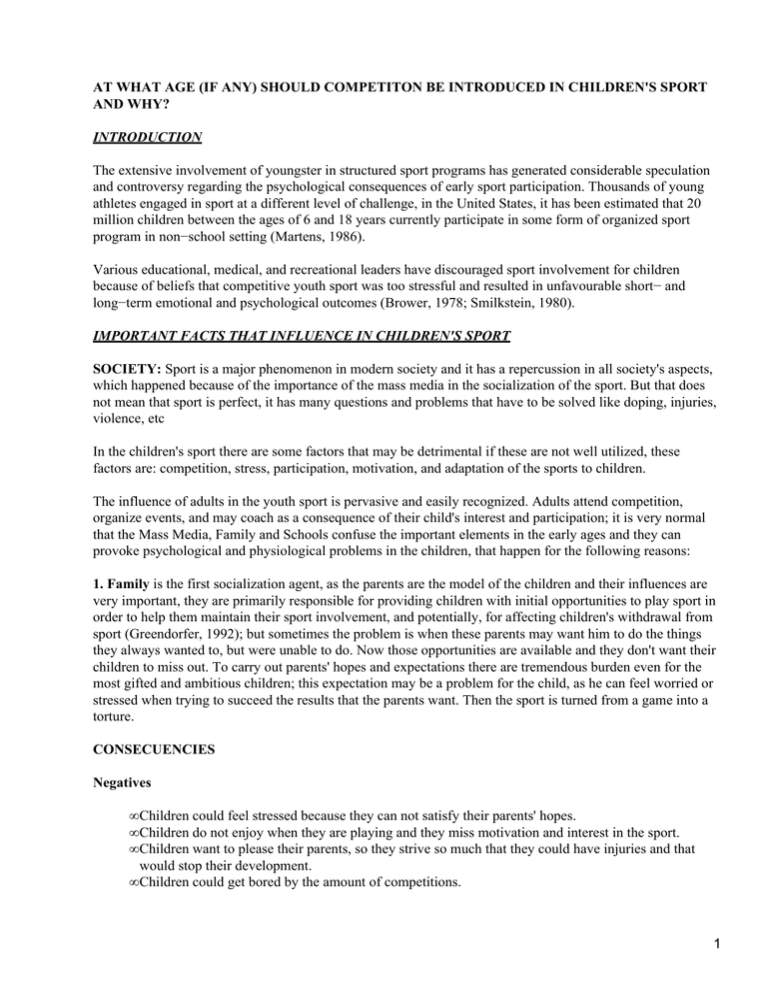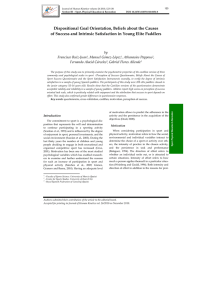Children's sport
Anuncio

AT WHAT AGE (IF ANY) SHOULD COMPETITON BE INTRODUCED IN CHILDREN'S SPORT AND WHY? INTRODUCTION The extensive involvement of youngster in structured sport programs has generated considerable speculation and controversy regarding the psychological consequences of early sport participation. Thousands of young athletes engaged in sport at a different level of challenge, in the United States, it has been estimated that 20 million children between the ages of 6 and 18 years currently participate in some form of organized sport program in non−school setting (Martens, 1986). Various educational, medical, and recreational leaders have discouraged sport involvement for children because of beliefs that competitive youth sport was too stressful and resulted in unfavourable short− and long−term emotional and psychological outcomes (Brower, 1978; Smilkstein, 1980). IMPORTANT FACTS THAT INFLUENCE IN CHILDREN'S SPORT SOCIETY: Sport is a major phenomenon in modern society and it has a repercussion in all society's aspects, which happened because of the importance of the mass media in the socialization of the sport. But that does not mean that sport is perfect, it has many questions and problems that have to be solved like doping, injuries, violence, etc In the children's sport there are some factors that may be detrimental if these are not well utilized, these factors are: competition, stress, participation, motivation, and adaptation of the sports to children. The influence of adults in the youth sport is pervasive and easily recognized. Adults attend competition, organize events, and may coach as a consequence of their child's interest and participation; it is very normal that the Mass Media, Family and Schools confuse the important elements in the early ages and they can provoke psychological and physiological problems in the children, that happen for the following reasons: 1. Family is the first socialization agent, as the parents are the model of the children and their influences are very important, they are primarily responsible for providing children with initial opportunities to play sport in order to help them maintain their sport involvement, and potentially, for affecting children's withdrawal from sport (Greendorfer, 1992); but sometimes the problem is when these parents may want him to do the things they always wanted to, but were unable to do. Now those opportunities are available and they don't want their children to miss out. To carry out parents' hopes and expectations there are tremendous burden even for the most gifted and ambitious children; this expectation may be a problem for the child, as he can feel worried or stressed when trying to succeed the results that the parents want. Then the sport is turned from a game into a torture. CONSECUENCIES Negatives • Children could feel stressed because they can not satisfy their parents' hopes. • Children do not enjoy when they are playing and they miss motivation and interest in the sport. • Children want to please their parents, so they strive so much that they could have injuries and that would stop their development. • Children could get bored by the amount of competitions. 1 Positives • Parents can make their children start and love the practise of sport • Parents can help their children when becoming stressful. • Parents can control the aggression in the competition and avoid the use of violence. • Schools, most of schools require physical education classes, but it becomes a problem in the schools that have historically reinforced sport participation just for the prestige of the school. That means that the participation of all the members of the team is not important and most of the times only the best players play; this is foiled for the rest of the players and a loss of motivation in the sport, as they may feel discriminated. We should not forget the untrained teachers, they do not have the basic skills for what the youths athletes can improve and they do not miss the interest in the sport. Another important factor are friends and mates, who sometimes influence strongly in the practise of the sport, or vice versa. CONSECUENCIES Negatives • Discrimination of the children : only the best players play. • The coaching are very competitive, there is a loss of the funny side. • The most important thing is the result and the prestige of the school, not the development of the children, or at least it is secondary. • Violence will probable appear. Positives • Preoccupation for the development of the children in all aspects psychological and physiological. • Utilize the sport like a way of socialization of the children. • Utilize the competitive element to improve their skills and their character. • Mass Media is also the most important factor in sport socialization. Children are bombarded with sports through several forms of media including television, newspapers, and magazines, even the parents are very influenced by the Mass Media. The children watch a competitive model, where the results are more important than the participation; where there is a specialization of the players; where the athletes compete to improve the records and sometimes they use violence and frauds like doping; besides, children are watching constantly how the sport's stars become very glamorous and famous. All this has a great influence in the children (parents and coaches too), who want to imitate their idols. They confuse the actual game with the professional sport whose characteristics are: specialization, quantification, records, results in short time in fact, when children do not succeed to imitate their idols, they get frustrated and stressed because their hopes are out of reach and they see how they cannot be able to follow the steps of their stars. CONSECUENCIES Negatives • The Mass Media gives us an image of the sport being very competitive and aggressive and that has an important influence in the society. • Children watch how their idols make traps or use aggressions and violence only to win. • In the Mass Media all is exaggerated and that influences on the children. Positives 2 • The Mass Media has succeeded that sport is a social phenomenon. What are we looking for with the sport in the children? When we are asking that question we have to think in their motor control, environment and their psychology. Between 6−12 years old children are improving their basic skills and capacities. Between these ages it is very good to start the specialization skills in any sport, but we cannot forget that they are developing and therefore we cannot risk their health only for our interest. Besides, we have to watch over our children so that they do not run health risks, as they tend to compete at their maximum level, forgetting that it is only a game. The fundamental stage is well structured and it is fun! The emphasis is on the overall development of the athlete's physical capacities, and fundamental movement skills, and the ABC's of athleticism − Agility, Balance, Coordination and Speed. Participation in as many sports as possible is encouraged. Speed, power and endurance are developed using FUN games. Correct running, jumping and throwing techniques are taught, using the ABC's of athletics. CONCLUSION As a conclusion I would like to say that sport can be very important in the development of the children and youth athletes, but we have to be aware of what sport is and not to think about it only as a competition, where the most important thing is the result and not the development. Specially we have to watch over to the earliest athletes where the main objective is the development in a fun environment. At these ages, a bad experience could create a trauma in the child making him/her not wanting to practise sport again. Competition should start between the ages of 8 and 12, but it shouldn't be the main target, as it could strengthen the character of the young athletes. Fun is the most important thing when developing a child in his/her early ages. DEFINITIONS Stress: Competitive stress in the negative emotional reaction of a child feels when his/her self−steem is threatened. This personal threat occurs when the young athlete perceives an imbalance between the performance demands of the competition and his/her own ability to successfully meet those demands, under conditions where the consequences of such a failure are thought to be important (Marteens, 1977) Aggression: aggression involves the intention to hurt or emerge superior to others; it does not necessarily involve physical injury (violence), and may or may not be regarded as being underpinned by different kinds of motives. Parents consider aggressions to be the attempt to control, act upon, and master ourselves and our environment, including the people within it Parents see aggression as having two major forms, the first being non−destructive aggression manifested as assertive, nonhostile, self−protective, goal−achieving and mastery behaviours the second form is, he says hostile, destructiveness, which we see in angry, nasty, hurtful behaviours: hate, rage, bullying, torturing, vengefulness Overview of Long−term Athlete Development FUNdamental Training to Train Training to Compete Training to Win Chronological / Biological Age Biological Age Male & Female: 6 −10 Chronological I Biological Chronological Age Age Male: 18+ Female: 17 + 3 • FUN and participation • General, overall development • Athleticism: ABC's of running, jumping and throwing • ABC's of movement Agility, Balance, Co−ordination and Speed • Speed, power and endurance through FUN and games • Proper running, jumping and throwing technique • Medicine ball. Swiss ball and own body exercises for strength • Introduction to simple rules and ethics of sport Talent Identification NO periodization, but well structured programs • Sport participation 5 −6 times per week Male: 10− 14 Female: 10− 13 Male: 14− 18 Female: 13− 17 • Maintenance (or possible improvement) of physical capacities • Shoulder, elbow, core, spine and ankle stability • Further development of technical, tactical and playing skills • Modelling all possible aspects of training and performance • Frequent prophylactic breaks • All aspects of training • Individualized • Develop further "ancillary capacities" (there is no ceiling limit) • Emphasis on general physical • Sport and conditioning individual specific • Shoulder, elbow, physical core, spine and conditioning ankle stability • Shoulder, elbow, • FUNdamental core, spine and technical skills ankle stability progressively • Sport−specific more specific technical and skills towards the playing skills end of the stage under competitive • FUNdamentals of conditions tactical • Advanced tactical preparation preparation • Participation in • Individualization complementary of technical sports; (similar −tactical skins energy system and • Advanced mental movement pattern preparation requirements) • Sport and • Individualization individual specific of fitness and "ancillary technical training capacities" High Performance • Introduction to mental preparation Specialization Triple or multiple • FUNdamentals of Periodization ancillary Double or Multiple capacities Periodization • Sport−specific technical, tactical Recruitment • Sport−specific and fitness technical, tactical training 9−12 Single Periodization and fitness times per week training 6 −9 • Sport −specific times per week training 4 times per week, with participation in other sports BIBLYOGRAPHY • Eldon E. snyder/ Elmer A spreitzer. Social aspects of sport • David L. Gallahue. Developmental physical education for today's children • Albinson and Andrew. Child in sport and physical activity • Coakley, J (1986). Mr Weiss and Gould (EDS). Sport for children and youths. Champaign Illinois: Human kinetics • Moral psychology in the context of sport. Light Bredemier, BJ and Light shields, DL (1993), Handbook of research on sport psychology. 4



